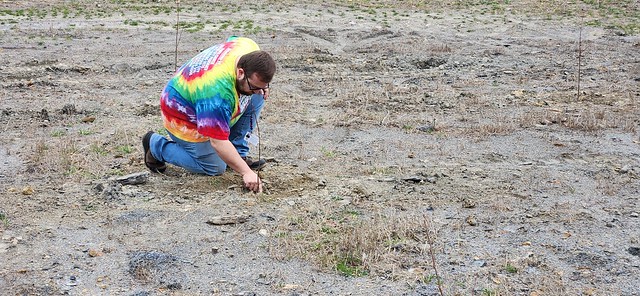In the weeks surrounding Arbor Day, former coal mine sites in Appalachia sprout new seeds as volunteers from around the region gather to plant trees. Dense forests are a staple of the Eastern U.S. but have declined dramatically since the early 1800s. Former coal mine sites provide the opportunity to remediate the land while supporting our native ecosystems. Here are four projects organized by OSMRE and partners in March and April; everyday is Arbor Day at OSMRE.
Tennessee Arbor Day Event
March 28
The Office of Surface Mining Reclamation and Enforcement’s Lexington Field Office, in partnership with the Coal Creek Watershed Foundation, The Nature Conservancy, and the Appalachian Regional Reforestation Initiative, held an Arbor Day event on March 28, at an abandoned mine site in Claiborne County, Tennessee.
Volunteer students and educators learned about forestry management and efforts to manage timber in central Appalachia, as well as the history of the American chestnut and ongoing efforts to re-establish it. The Arbor Day event culminated in the planting of 52 hybrid American chestnut trees donated by the American Chestnut Foundation.
Participants
OSMRE: D. Jason Taylor, Whitney Nash, William DeBord
Coal Creek Watershed Foundation: Barry Thacker, Carol Moore
The Nature Conservancy: Mark Rogers
Kentucky Arbor Day Event
April 5
OSMRE’s Lexington Field Office participated in an Arbor Day event on April 5.
The event was held on a 2-acre former coal mine site in Perry County, Kentucky. Prior to the tree planting, volunteers were taught about mine reclamation and the Forestry Reclamation Approach, with instruction on proper tree planting techniques. The event culminated in the planting of 1,600 trees native to the Appalachian region, including silky dogwood, white oak, shortleaf pine, chestnut oak, persimmon, black cherry, and northern red oak. Volunteers joined elementary and middle school students to accomplish the planting.
The event was sponsored by Kentucky River Properties, LLC; Pine Branch Mining, LLC; the Kentucky Energy & Environment Cabinet, Kentucky Division of Forestry, Green Forests Work, Perry County Conservation District, the Appalachian Regional Reforestation Initiative, The Arbor Day Foundation, and OSMRE.
Green Forests Work at TNC’s Ataya property
March 7, 25, 28 & 29
This spring, OSMRE partner Green Forests Work reforested 94 acres on The Nature Conservancy's Ataya property in Leslie and Harlan counties, Kentucky. The project was made possible with a grant from the National Fish and Wildlife Foundation. GFW hired contractors to remove invasive vegetation and cross-rip compacted ground prior to the tree planting. A combination of professional and volunteer planters, including groups from the University of Kentucky, Radford University, Berea College, and Beam Suntory, planted nearly 64,000 trees across the site to restore an upland oak-shortleaf pine community. The Arbor Day Foundation and The American Chestnut Foundation also provided new hybrid American chestnut seedlings for the planting. In total, 18 different species of native trees and shrubs were planted, and 500 pounds of native warm-season grass and wildflower seeds were spread in order to benefit pollinators and wildlife.
Virginia Arbor Day
April 20
On April 20, the Virginia Department of Energy celebrated the 17th Annual Virginia Arbor Day with a tree planting at a reclaimed coal mine site that is now managed by The Nature Conservancy. Nearly 100 ninth-grade earth science students from Wise County volunteered to plant over 1,000 trees. Other partners at the event included The Nature Conservancy, Virginia Department of Forestry, Virginia Department of Transportation, the Metallurgical Coal Producers Association, and OSMRE.
Volunteers planted red and white oak, maple, locust, dogwood, persimmon, apple, and pine trees across three acres. Since Virginia’s first Arbor Day celebration in 2005, over 11,000 trees have been planted on nearly 45 acres of previously mined land. In addition to tree plantings, students had the opportunity for hands-on learning at educational booths. Activities included interactive presentations using a model surface mine and testing out work equipment and technology used by Virginia Energy’s mine rescue team.





